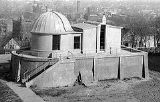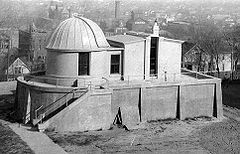
Creighton University Observatory
Encyclopedia
Creighton University Observatory is located on the Creighton University
campus in Omaha
, Nebraska
. It was the first observatory in Omaha, and the second in Nebraska. It was used primarily for instruction of students, though the directors did do some research in the observatory. It still stands today on the campus grounds, though there is currently no public access.

, John A. Creighton
donated the money for a telescope
made by J.H. Steward & Co. of London
.
He suggested a small shed with a removable roof. Father Dowling, the university president, was able to secure $1200 from Mr. Creighton for building a proper observatory
.
Creighton University
Creighton University is a private, coeducational, Jesuit, Roman Catholic university located in Omaha, Nebraska, United States. Founded by the Society of Jesus in 1878, the school is one of 28 member institutions of the Association of Jesuit Colleges and Universities. The university is accredited by...
campus in Omaha
Omaha, Nebraska
Omaha is the largest city in the state of Nebraska, United States, and is the county seat of Douglas County. It is located in the Midwestern United States on the Missouri River, about 20 miles north of the mouth of the Platte River...
, Nebraska
Nebraska
Nebraska is a state on the Great Plains of the Midwestern United States. The state's capital is Lincoln and its largest city is Omaha, on the Missouri River....
. It was the first observatory in Omaha, and the second in Nebraska. It was used primarily for instruction of students, though the directors did do some research in the observatory. It still stands today on the campus grounds, though there is currently no public access.
Quick facts

- Construction Began: Oct. 6, 1885
- Benefactor: John A. Creighton
- Telescope Mounted: May 6, 1886
- First Telescope: 1884 J. H. Stweard & Co. of LondonLondonLondon is the capital city of :England and the :United Kingdom, the largest metropolitan area in the United Kingdom, and the largest urban zone in the European Union by most measures. Located on the River Thames, London has been a major settlement for two millennia, its history going back to its...
, 5” apertureApertureIn optics, an aperture is a hole or an opening through which light travels. More specifically, the aperture of an optical system is the opening that determines the cone angle of a bundle of rays that come to a focus in the image plane. The aperture determines how collimated the admitted rays are,...
, 84” focal lengthFocal lengthThe focal length of an optical system is a measure of how strongly the system converges or diverges light. For an optical system in air, it is the distance over which initially collimated rays are brought to a focus...
. - First Light: Aug. 22, 1886
- Directors:
- Father Joseph Rigge, S.J. (1883-1894)
- Father Charles J. Borgmeyer (1894-1895)
- Father William F. Rigge, S.J. (1895-1927)
- Father William Doyle, S.J. (1927-1930)
History
As part of his endowment to found Creighton UniversityCreighton University
Creighton University is a private, coeducational, Jesuit, Roman Catholic university located in Omaha, Nebraska, United States. Founded by the Society of Jesus in 1878, the school is one of 28 member institutions of the Association of Jesuit Colleges and Universities. The university is accredited by...
, John A. Creighton
John A. Creighton
Count John A. Creighton was a pioneer businessman and philanthropist in Omaha, Nebraska who founded Creighton University...
donated the money for a telescope
Telescope
A telescope is an instrument that aids in the observation of remote objects by collecting electromagnetic radiation . The first known practical telescopes were invented in the Netherlands at the beginning of the 1600s , using glass lenses...
made by J.H. Steward & Co. of London
London
London is the capital city of :England and the :United Kingdom, the largest metropolitan area in the United Kingdom, and the largest urban zone in the European Union by most measures. Located on the River Thames, London has been a major settlement for two millennia, its history going back to its...
.
Telescope statistics
- ApertureApertureIn optics, an aperture is a hole or an opening through which light travels. More specifically, the aperture of an optical system is the opening that determines the cone angle of a bundle of rays that come to a focus in the image plane. The aperture determines how collimated the admitted rays are,...
– 5 inches - Focal Length – 84 inches
- Mount – Equatorial, on a brassBrassBrass is an alloy of copper and zinc; the proportions of zinc and copper can be varied to create a range of brasses with varying properties.In comparison, bronze is principally an alloy of copper and tin...
column on an oakOakAn oak is a tree or shrub in the genus Quercus , of which about 600 species exist. "Oak" may also appear in the names of species in related genera, notably Lithocarpus...
tripod with 3 large castors - Mounting Gear – Driving Clock, graduated circles, clamps and fine adjustment screws on both axes.
- Eyepieces – 7 total (1 terrestrial, 1 diagonal, 5 astronomical)
- Initial storage – In the chemistry laboratory, rolled out as needed.
- Cost – 125£ or approximately $625 US
- Usage Intent – popular and educational use
Observatory built
Father Joseph Rigge, S.J. arrived at Creighton in August 1885. Assuming responsibility for the telescope, he noted that the constant movement of rolling the telescope in an out of its storage space did not allow for accurate usage and was even damaging the telescope.He suggested a small shed with a removable roof. Father Dowling, the university president, was able to secure $1200 from Mr. Creighton for building a proper observatory
Observatory
An observatory is a location used for observing terrestrial or celestial events. Astronomy, climatology/meteorology, geology, oceanography and volcanology are examples of disciplines for which observatories have been constructed...
.
Observatory statistics
- Ground Broken – October 6, 1885
- Building Completion – December 17, 1885
- Telescope Mounted – May 6, 1886
- Pier composition – Stone
- Central Pier Depth – 6 feet
- Central Pier Height from floor – 6 feet
- Circumference of Dome Room – 15 feet

